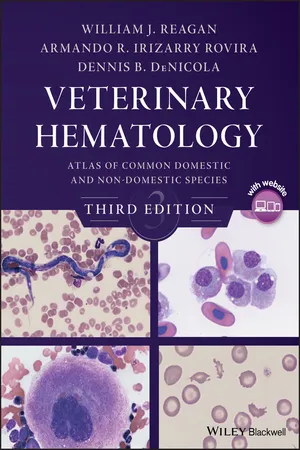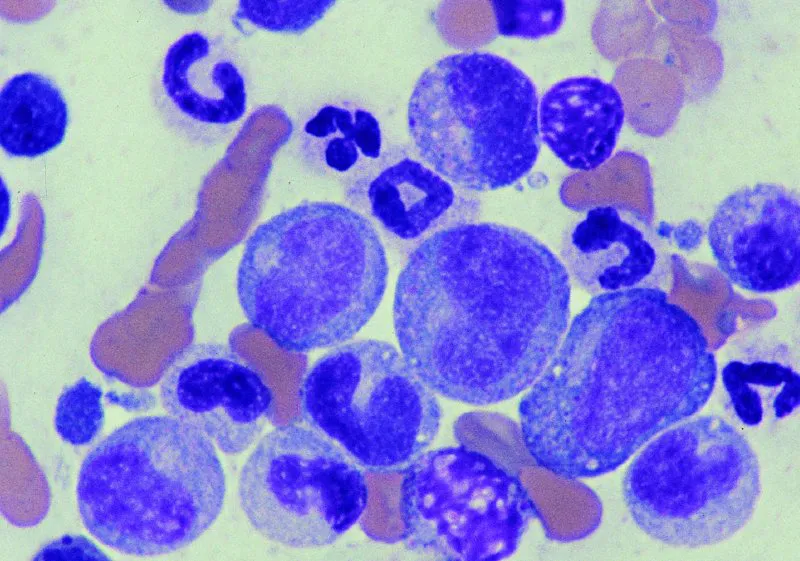
Veterinary Hematology
Atlas of Common Domestic and Non-Domestic Species
- English
- ePUB (mobile friendly)
- Available on iOS & Android
Veterinary Hematology
Atlas of Common Domestic and Non-Domestic Species
About this book
Now in its third edition, Veterinary Hematology: Atlas of Common Domestic and Non-Domestic Species continues to offer veterinarians and veterinary technicians an essential guide to veterinary hematology. Comprehensive in scope, the atlas presents the fundamentals of both normal and abnormal blood cell morphologies, with coverage of a wide range of species, including dogs, cats, horses, ruminants, llamas, rats, mice, nonhuman primates, ferrets, rabbits, guinea pigs, birds, amphibians, and reptiles.
Designed as a useful and accessible guide, the updated third edition presents more than 300 color images and includes a new chapter that describes the best techniques for using hematology instruments. The authors—noted experts on the topic—clearly show how to identify and interpret the hematological changes that may occur in a variety of species. In addition, a companion website offers a wealth of additional hematological images. This vital atlas:
- Provides an updated edition of the popular veterinary hematology atlas for veterinarians, veterinary students, and veterinary technicians
- Contains a new instructive chapter on hematology instrumentation
- Presents hundreds of high-quality color photographs that help in identification
- Covers a range of species from dogs and cats to birds and reptiles
- Features a companion website that provides a wealth of hematological images
Written for both novice and experienced veterinarians, Veterinary Hematology provides a complete resource to blood morphologic abnormalities in domestic and non-domestic species.
Frequently asked questions
- Essential is ideal for learners and professionals who enjoy exploring a wide range of subjects. Access the Essential Library with 800,000+ trusted titles and best-sellers across business, personal growth, and the humanities. Includes unlimited reading time and Standard Read Aloud voice.
- Complete: Perfect for advanced learners and researchers needing full, unrestricted access. Unlock 1.4M+ books across hundreds of subjects, including academic and specialized titles. The Complete Plan also includes advanced features like Premium Read Aloud and Research Assistant.
Please note we cannot support devices running on iOS 13 and Android 7 or earlier. Learn more about using the app.
Information
CHAPTER ONE
Hematopoiesis
General Features





Table of contents
- Cover
- Titlepage
- Copyright
- Preface
- About the Authors
- About the Companion Website
- CHAPTER ONE Hematopoiesis
- CHAPTER TWO Normal Red Blood Cell Morphology
- CHAPTER THREE Variations in Red Blood Cell Morphology
- CHAPTER FOUR Red Blood Cell Inclusions and Parasites
- CHAPTER FIVE Normal White Blood Cell Morphology
- CHAPTER SIX Variations in White Blood Cell Morphology
- CHAPTER SEVEN White Blood Cell Inclusions and Parasites
- CHAPTER EIGHT Platelets
- CHAPTER NINE Lymphoproliferative and Myeloproliferative Disorders
- CHAPTER TEN Miscellaneous Findings
- CHAPTER ELEVEN Avian Hematology
- CHAPTER TWELVE Reptilian and Amphibian Hematology
- CHAPTER THIRTEEN Integration of Blood Film and Hematology Analyzer Cytograms
- Appendix A Semiquantitative Grading Scheme for Evaluation of Red Blood Cell Morphology*
- Appendix B Semiquantitative Grading Scheme for Evaluation of Neutrophil Toxicity
- Bibliography
- Glossary
- Index
- WILEY END USER LICENSE AGREEMENT